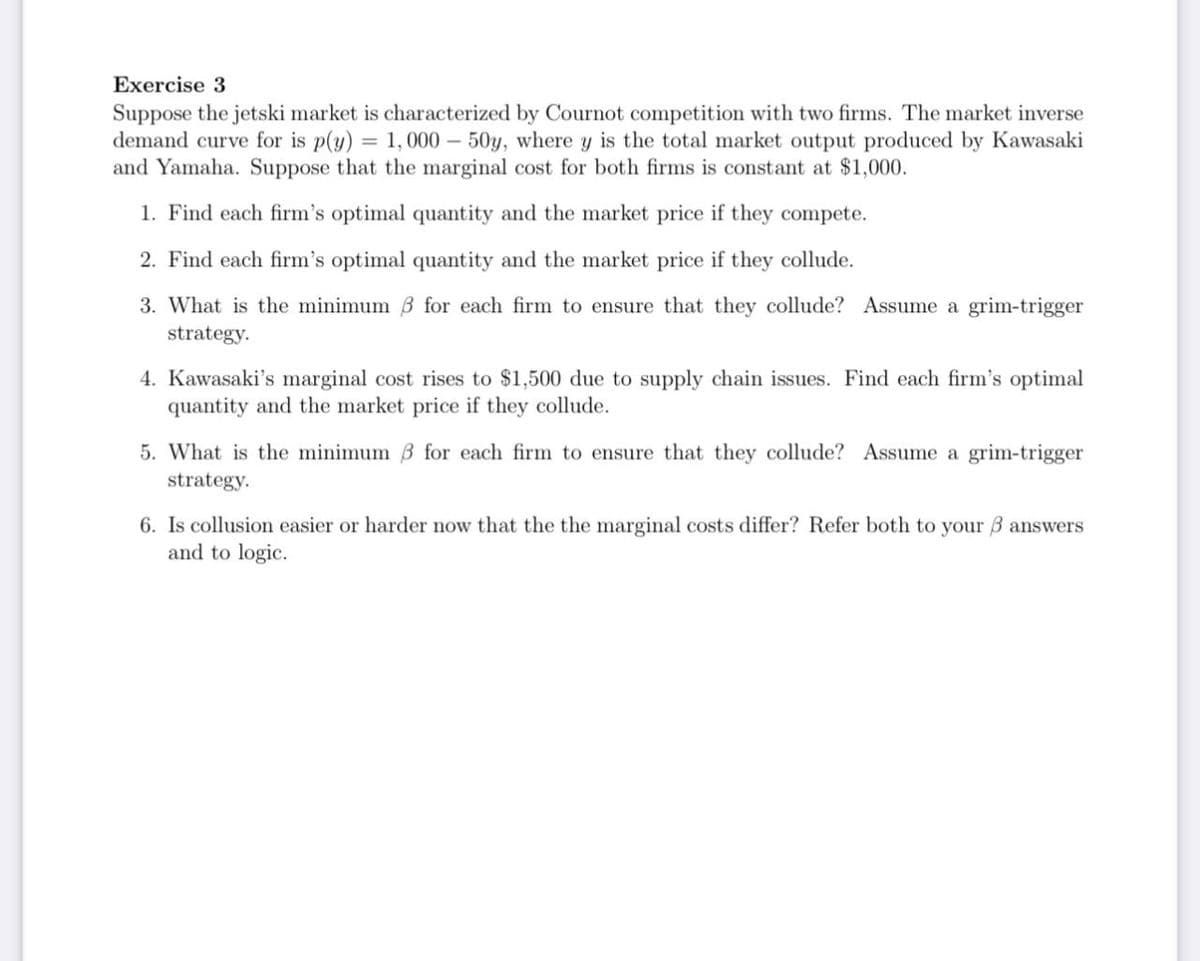Exercise 3 Suppose the jetski market is characterized by Cournot competition with two firms. The market inverse demand curve for is p(y) = 1,000-50y, where y is the total market output produced by Kawasaki and Yamaha. Suppose that the marginal cost for both firms is constant at $1,000. 1. Find each firm's optimal quantity and the market price if they compete. 2. Find each firm's optimal quantity and the market price if they collude. 3. What is the minimum ẞ for each firm to ensure that they collude? Assume a grim-trigger strategy. 4. Kawasaki's marginal cost rises to $1,500 due to supply chain issues. Find each firm's optimal quantity and the market price if they collude. 5. What is the minimum 3 for each firm to ensure that they collude? Assume a grim-trigger strategy. 6. Is collusion easier or harder now that the the marginal costs differ? Refer both to your ẞ answers and to logic.
Exercise 3 Suppose the jetski market is characterized by Cournot competition with two firms. The market inverse demand curve for is p(y) = 1,000-50y, where y is the total market output produced by Kawasaki and Yamaha. Suppose that the marginal cost for both firms is constant at $1,000. 1. Find each firm's optimal quantity and the market price if they compete. 2. Find each firm's optimal quantity and the market price if they collude. 3. What is the minimum ẞ for each firm to ensure that they collude? Assume a grim-trigger strategy. 4. Kawasaki's marginal cost rises to $1,500 due to supply chain issues. Find each firm's optimal quantity and the market price if they collude. 5. What is the minimum 3 for each firm to ensure that they collude? Assume a grim-trigger strategy. 6. Is collusion easier or harder now that the the marginal costs differ? Refer both to your ẞ answers and to logic.
Managerial Economics: Applications, Strategies and Tactics (MindTap Course List)
14th Edition
ISBN:9781305506381
Author:James R. McGuigan, R. Charles Moyer, Frederick H.deB. Harris
Publisher:James R. McGuigan, R. Charles Moyer, Frederick H.deB. Harris
Chapter12: Price And Output Determination: Oligopoly
Section: Chapter Questions
Problem 3E
Related questions
Question
None

Transcribed Image Text:Exercise 3
Suppose the jetski market is characterized by Cournot competition with two firms. The market inverse
demand curve for is p(y) = 1,000-50y, where y is the total market output produced by Kawasaki
and Yamaha. Suppose that the marginal cost for both firms is constant at $1,000.
1. Find each firm's optimal quantity and the market price if they compete.
2. Find each firm's optimal quantity and the market price if they collude.
3. What is the minimum ẞ for each firm to ensure that they collude? Assume a grim-trigger
strategy.
4. Kawasaki's marginal cost rises to $1,500 due to supply chain issues. Find each firm's optimal
quantity and the market price if they collude.
5. What is the minimum 3 for each firm to ensure that they collude? Assume a grim-trigger
strategy.
6. Is collusion easier or harder now that the the marginal costs differ? Refer both to your ẞ answers
and to logic.
Expert Solution
This question has been solved!
Explore an expertly crafted, step-by-step solution for a thorough understanding of key concepts.
This is a popular solution!
Trending now
This is a popular solution!
Step by step
Solved in 2 steps

Recommended textbooks for you

Managerial Economics: Applications, Strategies an…
Economics
ISBN:
9781305506381
Author:
James R. McGuigan, R. Charles Moyer, Frederick H.deB. Harris
Publisher:
Cengage Learning


Microeconomics: Principles & Policy
Economics
ISBN:
9781337794992
Author:
William J. Baumol, Alan S. Blinder, John L. Solow
Publisher:
Cengage Learning

Managerial Economics: Applications, Strategies an…
Economics
ISBN:
9781305506381
Author:
James R. McGuigan, R. Charles Moyer, Frederick H.deB. Harris
Publisher:
Cengage Learning


Microeconomics: Principles & Policy
Economics
ISBN:
9781337794992
Author:
William J. Baumol, Alan S. Blinder, John L. Solow
Publisher:
Cengage Learning